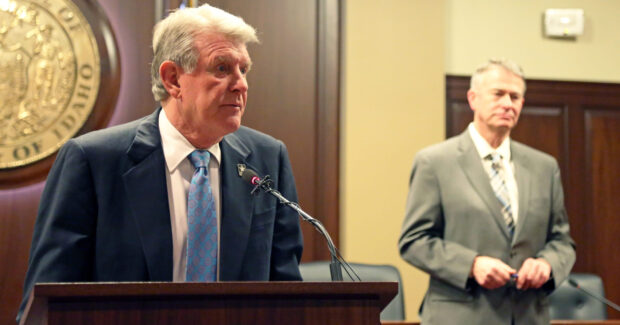Gov. Butch Otter didn’t break any news — at least on education — in his final pre-session meeting with reporters.
He again said education would be his top priority. He said he sees “great possibilities” in the 13 recommendations from his higher education task force. And he riffed again on his big reveal from Thursday, when he said he would push for a “chief education officer” to streamline Idaho’s higher education system.
All in all, Otter’s 10th appearance at the Associated Press’ annual legislative preview was an uneven and disjointed event.
In his last year as governor, Otter spent some of the hour taking a nostalgic tone — talking about the challenges he faced during the Great Recession and the health of the Idaho economy going forward. He talked at length about Idaho’s plans for the Hewlett-Packard campus in west Boise, which state agencies will share with the company. Otter ceded no small amount of time to his preferred gubernatorial candidate, Lt. Gov. Brad Little, as part of a lengthy walk-through on an executive order on health care.

The question-and-answer session was limited to less than 20 minutes. And Otter brushed off one question out of hand — refusing to comment about tax reform.
To be fair, there is always a certain amount of shuck and jive in Otter’s pre-legislative preview. Otter assiduously tries to avoid scooping himself, and divulging details ahead of his annual State of the State address. On Monday, Otter will kick off the 2018 legislative session with his 12th and final State of the State address. Spoiler alert: Otter told reporters to expect “a positive message.”
So it was unusual to see Otter set aside his self-imposed cone of silence Thursday, when told the State Board of Education that he would push for the higher education “CEO.” And when he was asked about higher education affordability — and student fees that are growing well beyond the rate of inflation — he used the opening to elaborate on the CEO proposal.
He predicted that a CEO could find cost savings in any number of areas, eliminating costly duplication across the state’s eight college and university campuses. He cited the experience in Maine, which created a similar position during the recession. Maine’s process is ongoing, but the state has found $80 million a year in cost savings, said Marilyn Whitney, Otter’s aide on education issues.
“There’s a lot of things that we can do on a consolidated basis,” Otter told reporters. “It just makes sense and I don’t know why we haven’t thought of it before.”
Later Friday morning, House Minority Leader Mat Erpelding took a different tack on the affordability issue, and said it comes back to Idaho’s commitment to higher education. When Erpelding graduated from Idaho State University in 1997, higher education received 12 percent of the state’s general fund budget. This year, higher education’s share is 8 percent.
“And the problem is we’ve added at least two schools,” said Erpelding, D-Boise, referring to the newly minted College of Eastern Idaho and the rapidly growing College of Western Idaho.
In his last year as governor, Otter clearly is tying his higher education legacy to his task force, a 36-member group that included his State Board of Education appointees, university presidents, business leaders and a bipartisan group of six legislators. And, no news here, Otter is hoping recent education history will repeat itself.
“I wanted to replicate the success we had with the K-12 task force,” Otter told reporters.
But success isn’t assured. The CEO proposal still needs to be fleshed out, but business leaders have floated a rough cost estimate of $2.5 million, which could be sufficient to rankle Statehouse conservative. The task force is rekindling a familiar Otter idea that has stalled out for the past two legislative sessions: a $3 million “adult completer” scholarship designed to help Idahoans return to school and finish a degree.
Otter didn’t say much about education Friday. And it almost certainly wasn’t the last word.
